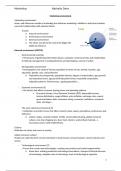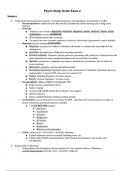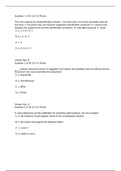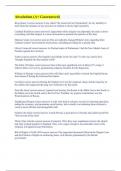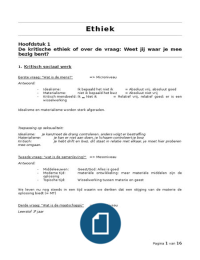Marketing Nathalie Dens
Marketing environment
Marketing environment:
Actors and influences outside of marketing that influence marketing’s abilities to build and maintain
successful relationships with selected clients
- 3 levels
o Internal environment
o Performance environment
o External environment
o The closer you get to the centre the bigger the
ability to influence
External environment (PESTLE)
- Environmental scanning
= The process of gathering information about a company’s external events and relationships
to help top management in making decisions and developing a course of action
- Demographic environment
= Demography is the study of human population in terms of size, density, location, age,
education, gender, race, and profession
o Population size and growth, population density, degree of urbanization, age pyramid
and education levels, age pyramid/education levels, household composition,
migration patterns, infrastructure, ageing population, …
- Economic environment (E)
= the factors that affect consumer buying power and spending patterns
Economic climate, Gross Domestic Product (GDP), disposable income,
income distribution, wage inflation, price inflation, exchange rates, export
quota and duties, debt, consumer saving, consumer confidence, economic
state, shortages, …
- The socio-cultural environment (S)
= Institutions and other forces that affect society’s basic values, perceptions, preferences and
behaviors
o Culture, hypes, societal mindset, COVID, communities/sharing, global consumer
culture, one-stop shopping (ex. Ikea: food, interior, work/school material,…),
increased concern with health/fitness
Culture:
Reflection of values and norms in society
Global consumer culture:
People are united by their common devotion to brand-name consumer goods, movie/rockstars and
service
- Technological environment (T)
= Forces that create new technologies, creating new product and market opportunities
o Know-how, existing production technology/innovations, changes in lifestyle because
of technology, adoption rate of technology, level of technological expertise,
1
, Marketing Nathalie Dens
information access (e.g., Internet), technical issues, disruptive technologies,
crowdsourcing
Disruptive innovation:
Innovation that creates a new market and value network and eventually disrupts an existing market
and value network, displacing established market-leading firms, products, and alliances
Crowdsourcing:
Identify a task or group of tasks currently conducted in-house and then to release the tasks to a
‘crowd’ of outsiders, who are invited to perform the tasks on behalf of the company for a fee or prize
- Ecological environment (E)
= Natural resources needed as inputs or affected by marketing activities
o Trends:
growing shortage of raw materials, increased cost of energy, increased pollution and
climate change, increased government intervention, increasing numbers of
consumers expressing concern about companies’ impact on ecological environments:
Increased concern for ‘organic’ food, animal welfare, pesticides and chemical
fertilizers
o Green marketing strategies
Eco-efficiency
Lower costs by means of improved organizational processes, such as the
promotion of resource productivity (e.g., energy efficiency) and better
utilization of by-products.
Beyond compliance leadership
Adoption of a differentiation strategy to demonstrate the company’s
ecological credentials or its environmental excellence.
Eco-branding
Differentiate products or services to promote environmental responsibility
Environmental cost leadership
Offerings that provide greater environmental benefits at a lower price
- Political-legal environment (P,L)
= Laws, government agencies and pressure groups that influence and limit organizations and
individuals in a given society
o Companies can detect signals concerning potential legal and regulatory changes in
their industries and thus have a chance to impede, influence, and alter that
legislation.
o Business–government relations, properly undertaken, can be a source of sustainable
competitive advantage
o Trends:
Increasing regulation for companies, stronger emphasis on ethics and social
responsibility, growth of societal pressure groups, Legal constraints, COVID
measures, war, politics
o Influences:
Lobbying, public relations (PR), industry coalitions, placing politicians in board
2
Marketing environment
Marketing environment:
Actors and influences outside of marketing that influence marketing’s abilities to build and maintain
successful relationships with selected clients
- 3 levels
o Internal environment
o Performance environment
o External environment
o The closer you get to the centre the bigger the
ability to influence
External environment (PESTLE)
- Environmental scanning
= The process of gathering information about a company’s external events and relationships
to help top management in making decisions and developing a course of action
- Demographic environment
= Demography is the study of human population in terms of size, density, location, age,
education, gender, race, and profession
o Population size and growth, population density, degree of urbanization, age pyramid
and education levels, age pyramid/education levels, household composition,
migration patterns, infrastructure, ageing population, …
- Economic environment (E)
= the factors that affect consumer buying power and spending patterns
Economic climate, Gross Domestic Product (GDP), disposable income,
income distribution, wage inflation, price inflation, exchange rates, export
quota and duties, debt, consumer saving, consumer confidence, economic
state, shortages, …
- The socio-cultural environment (S)
= Institutions and other forces that affect society’s basic values, perceptions, preferences and
behaviors
o Culture, hypes, societal mindset, COVID, communities/sharing, global consumer
culture, one-stop shopping (ex. Ikea: food, interior, work/school material,…),
increased concern with health/fitness
Culture:
Reflection of values and norms in society
Global consumer culture:
People are united by their common devotion to brand-name consumer goods, movie/rockstars and
service
- Technological environment (T)
= Forces that create new technologies, creating new product and market opportunities
o Know-how, existing production technology/innovations, changes in lifestyle because
of technology, adoption rate of technology, level of technological expertise,
1
, Marketing Nathalie Dens
information access (e.g., Internet), technical issues, disruptive technologies,
crowdsourcing
Disruptive innovation:
Innovation that creates a new market and value network and eventually disrupts an existing market
and value network, displacing established market-leading firms, products, and alliances
Crowdsourcing:
Identify a task or group of tasks currently conducted in-house and then to release the tasks to a
‘crowd’ of outsiders, who are invited to perform the tasks on behalf of the company for a fee or prize
- Ecological environment (E)
= Natural resources needed as inputs or affected by marketing activities
o Trends:
growing shortage of raw materials, increased cost of energy, increased pollution and
climate change, increased government intervention, increasing numbers of
consumers expressing concern about companies’ impact on ecological environments:
Increased concern for ‘organic’ food, animal welfare, pesticides and chemical
fertilizers
o Green marketing strategies
Eco-efficiency
Lower costs by means of improved organizational processes, such as the
promotion of resource productivity (e.g., energy efficiency) and better
utilization of by-products.
Beyond compliance leadership
Adoption of a differentiation strategy to demonstrate the company’s
ecological credentials or its environmental excellence.
Eco-branding
Differentiate products or services to promote environmental responsibility
Environmental cost leadership
Offerings that provide greater environmental benefits at a lower price
- Political-legal environment (P,L)
= Laws, government agencies and pressure groups that influence and limit organizations and
individuals in a given society
o Companies can detect signals concerning potential legal and regulatory changes in
their industries and thus have a chance to impede, influence, and alter that
legislation.
o Business–government relations, properly undertaken, can be a source of sustainable
competitive advantage
o Trends:
Increasing regulation for companies, stronger emphasis on ethics and social
responsibility, growth of societal pressure groups, Legal constraints, COVID
measures, war, politics
o Influences:
Lobbying, public relations (PR), industry coalitions, placing politicians in board
2


